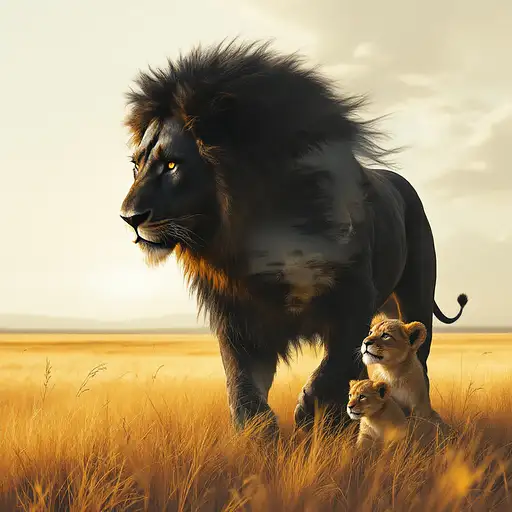6 months ago
Create a masterful double exposure oil painting that seamlessly blends the powerful and raw spirit of Rocky Balboa with the grit of the urban landscape. This painting should depict Rocky’s iconic figure in a way that fuses his inner strength, determination, and struggle with the world around him—transforming his character into a symbol of resilience, heart, and triumph.
In the foreground, Rocky’s muscular silhouette should dominate the canvas, painted with strong, bold strokes that evoke both movement and resolve. His stance should be poised mid-action—perhaps capturing a moment of intense training or the famous stance of raising his fists in victory atop the steps of the Philadelphia Museum of Art. His features should be captured in vivid detail, emphasizing his facial expressions that mix determination with vulnerability.
The double exposure effect should integrate an urban backdrop within Rocky’s form. His figure could be overlaid with elements of the city—gritty, dark streets of Philadelphia, alleyways lit by streetlights, the silhouettes of crumbling brick buildings, and the hard, unforgiving concrete of the urban landscape. These elements should weave in and out of his form, blending together through overlapping layers of paint to create a visual metaphor for his journey—a reflection of how the city’s harshness and his relentless drive are inseparable.
The cityscape could be infused with dynamic movement and texture—depicting the gritty energy of his environment. The use of dark shades like deep blues, grays, and blacks should contrast with the warmer tones of Rocky’s form—his flesh tones and the glow of street lamps reflecting determination and hope in the midst of struggle. Rocky’s body could almost seem to be emerging from or merging with the buildings, as if his strength is both shaped and fueled by the city around him.
The color palette should emphasize contrast—heavy use of dark, muted hues for the city and surrounding environment, while Rocky’s figure can be painted with more vivid, dynamic colors. Rich oranges, reds, and yellows might be used to highlight his energy and determination, especially where the light of a streetlamp or the reflection of the sun hits his face or body. These bright hues should symbolize his resilience, while the darker tones represent the challenges he faces.
Incorporate subtle details that nod to iconic scenes from the film—perhaps the shadow of a punching bag, the distant shape of a gym, or faint traces of Rocky’s training equipment overlaid within the composition. These references should feel integrated into the double exposure as a part of his identity, blending with his form, highlighting his journey from underdog to champion.
The double exposure technique should not just be a visual gimmick, but a narrative tool—showing the physical and emotional layers of Rocky’s character, both the raw toughness and the inner fragility, the battle within and the world he struggles to conquer. This painting should capture his essence as both a symbol of perseverance and the embodiment of the human spirit’s ability to rise against all odds.
Create a compelling double exposure oil painting that captures the ominous presence of the great white shark from Jaws while symbolizing the tension, fear, and raw power of the ocean. The painting should evoke both the terror of the shark and the vulnerability of those who encounter it, seamlessly blending the natural world with the looming menace that it represents.
In the foreground, the figure of the shark should emerge in dynamic, fluid strokes, its sleek, menacing form towering over the ocean waves. The shark’s details—its gaping mouth, rows of sharp teeth, and dark, cold eyes—should be painted with intense precision, capturing the moment of its predatory instinct. Its massive, sinuous body should dominate the composition, a shadow of terror that contrasts against the backdrop of the sea.
The double exposure effect should allow the ocean itself to blend into the shark’s form, illustrating the profound relationship between the creature and its environment. Swirling, turbulent waves, deep blues, and blacks of the water should blend into the shark’s body, as though the shark is part of the sea, emerging from it and vanishing into it simultaneously. Use the brushstrokes to create movement within the water—curving lines of foam, crashing waves, and undercurrents that suggest the danger lurking beneath the surface.
In the background, the faint outline of the beach, a small boat, or the silhouettes of the characters from the film, like Chief Brody or Quint, could be subtly incorporated within the double exposure, their forms almost indistinguishable from the ocean or sky. This technique should emphasize the scale of the shark compared to the human figures, highlighting the helplessness and fear they experience when facing such a formidable foe.
The colors should be a striking contrast between the cold, dark blues and blacks of the ocean depths and the sharp whites and grays of the shark, with occasional touches of deep crimson around its jaws, suggesting the violence of the attack. The sky above could have stormy, ominous clouds, painted in various shades of gray and muted oranges to reflect the tension and impending doom, as though the world itself is holding its breath.
The double exposure technique should also integrate the idea of impending danger—the gradual fading of light or shadow around the edges of the shark, emphasizing the idea that the predator is always lurking just out of sight. A subtle play of light and dark should create a haunting atmosphere, giving the viewer the sense that the shark is not just a physical threat, but a symbol of primal fear, the unknowable forces of nature, and the dark mysteries that lie beneath the surface.
This painting should evoke both the majesty and terror of Jaws, using the double exposure technique to weave together the natural world and the horror of the shark into one cohesive, unforgettable image. The result should be a masterpiece that taps into universal fears—of the unknown, of power, and of nature’s ability to both captivate and destroy.
























